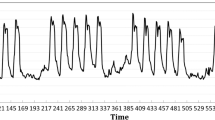Abstract
Electric grids are operated to ensure the provision and supply of electric power under suitable conditions at a minimum cost. However, the need for maintenance and repairs to equipment and transmission lines employed in the electric grid is constant and increasingly frequent; therefore, studies are necessary in the operational area in order to analyze and to enable the required services. Manipulations in an electric grid are necessary in order to allow preventive or corrective maintenance on the grid, thereby ensuring system operability. In this study, the primal-dual interior-point methods are used to minimize costs and losses in a predispatch model for the generation and transmission of direct current (DC) power flow in a hydroelectric system with pre-programmed manipulations; i.e., in cases of preventive maintenance, within a period of 24 h. From the computational standpoint, the effort required to solve a problem with and without manipulations is similar, and the reasons why will be also discussed in this study. Computational results corroborates these findings.








Similar content being viewed by others
References
Ahuja, R., Magnanti, T., & Orlin, J. B. (1993). Network flows. New Jersey: Prentice Hall.
Carvalho, L. M. R., & Oliveira, A. R. L. (2009). Primal dual interior point method appliede to the short term hydroelectric scheuling including a perturbing parameter. IEEE Latin America Transactions, 7, 533–539.
Carvalho, S. M. S., & Oliveira, A. R. L. (2015). Interior point methods applied to the predispatch hydroelectric system with simulated modification in the network topology. IEEE Latin America Transactions, 13, 143–149.
Carvalho, S. M. S., & Oliveira, A. R. L. (2012). Interior-point methods applied to the predispatch problem of a hydroelectric system with scheduled line manipulations. American Journal of Operations Research, 02, 266–271.
Duff, I. S., Erisman, A. M., & Reid, J. K. (1986). Direct methods for sparse matrices. Oxford: Clarendon Press.
Franco, P., Carvalho, M. F., & Soares, S. (1994). A network flow model for short-term hydro-dominated hydrothermal scheduling problem. IEEE Transactions on Power Systems, 9(2), 1016–1021.
Garzillo, A., Innorta, M., & Ricci, R. (1999). The flexibility of interior point based power flow algorithms facing critical network situations. Electrical Power & Energy Systems, 21, 579–584.
Momoh, J. A., El-Hawary, M. E., & Adapa, R. (1999). A review of selected optimal power flow literature to 1993, part II Newton, linear programming and interior point methods. IEEE Transactions on Power Systems, 14(1), 105–111.
Ohishi, T., Soares, S., & Carvalho, M. F. (1991). Short term hydrothermal scheduling approach for dominantly hydro systems. IEEE Transactions on Power Systems, 6(2), 637–643.
Oliveira, A. R. L., Soares, S., & Nepomuceno, L. (2003). Optimal active power dispatch combining network flow and interior point approaches. IEEE Transactions on Power Systems, 18(4), 1235–1240.
Oliveira, A. R. L., Soares, S., & Nepomuceno, L. (2005). Short term hydroelectric scheduling combining network flow and interior point approaches. Electrical Power & Energy Systems, 27(2), 91–99.
Quintana, V. H., Torres, G. L., & Palomo, J. M. (2000). Interior point methods and their applications to power systems: A classification of publications and software codes. IEEE Transactions on Power Systems, 15(1), 170–176.
Soares, S., & Salmazo, C. T. (1997). Minimum loss predispatch model for hydroelectric systems. IEEE Transactions on Power Systems, 12(3), 1220–1228.
Stott, B., Jardim, J., & Alsaç, O. (2009). DC power flow revisited. IEEE Transactions on Power Systems, 24, 1290–1300.
Terry, L. A., Pereira, M. V. F., Neto, T. A. A., Silva, L. F. C. A., & Sales, P. R. H. (1986). Coordinating the energy generation of the brazilian national hydrothermal electrical generating system. Interfaces, 16(1), 16–38.
Acknowledgements
This research was partially sponsered by the Foundation for the Support of Research of the State of São Paulo, (FAPESP) and the Brazilian Council for the Development of Science and Technology (CNPq).
Author information
Authors and Affiliations
Corresponding author
Rights and permissions
About this article
Cite this article
Carvalho, S.M.S., Oliveira, A.R.L. & Lyra, C. Predispatch of hydroelectric power systems with modifications in network topologies. Ann Oper Res 261, 135–153 (2018). https://doi.org/10.1007/s10479-017-2640-y
Published:
Issue Date:
DOI: https://doi.org/10.1007/s10479-017-2640-y




